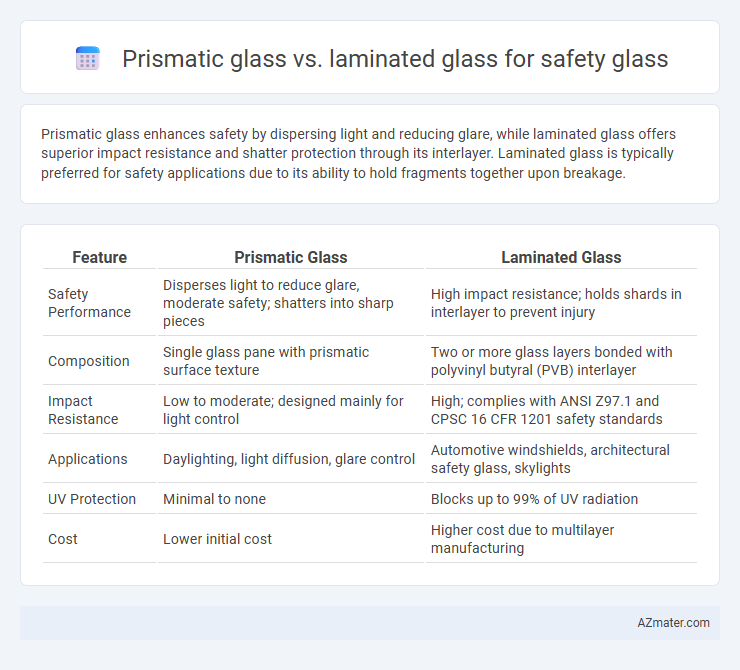Prismatic glass enhances safety by dispersing light and reducing glare, while laminated glass offers superior impact resistance and shatter protection through its interlayer. Laminated glass is typically preferred for safety applications due to its ability to hold fragments together upon breakage.
Table of Comparison
| Feature | Prismatic Glass | Laminated Glass |
|---|---|---|
| Safety Performance | Disperses light to reduce glare, moderate safety; shatters into sharp pieces | High impact resistance; holds shards in interlayer to prevent injury |
| Composition | Single glass pane with prismatic surface texture | Two or more glass layers bonded with polyvinyl butyral (PVB) interlayer |
| Impact Resistance | Low to moderate; designed mainly for light control | High; complies with ANSI Z97.1 and CPSC 16 CFR 1201 safety standards |
| Applications | Daylighting, light diffusion, glare control | Automotive windshields, architectural safety glass, skylights |
| UV Protection | Minimal to none | Blocks up to 99% of UV radiation |
| Cost | Lower initial cost | Higher cost due to multilayer manufacturing |
Introduction to Safety Glass: Prismatic vs Laminated
Safety glass plays a critical role in protecting occupants by minimizing injury risks during impact, with prismatic glass and laminated glass serving distinct functions. Prismatic glass utilizes geometric patterns to refract light while maintaining safety features, ideal for areas requiring natural illumination and security. Laminated glass consists of multiple glass layers bonded with an interlayer, providing superior impact resistance and preventing shattering, making it essential in automotive, architectural, and security applications.
What is Prismatic Glass?
Prismatic glass is designed with a textured surface that refracts light to reduce glare and enhance visibility, making it ideal for safety glass applications in environments requiring controlled illumination. Unlike laminated glass, which consists of multiple layers bonded with an interlayer for impact resistance and shatter protection, prismatic glass primarily improves light distribution while still offering moderate strength. Its unique optical properties contribute to both safety and energy efficiency in architectural and automotive glazing.
What is Laminated Glass?
Laminated glass consists of two or more layers of glass bonded together with an interlayer, usually made of polyvinyl butyral (PVB), providing enhanced safety by holding the glass fragments in place upon impact. This construction reduces the risk of injury and increases resistance to penetration and sound transmission, making laminated glass ideal for automotive windshields, skylights, and security applications. Unlike prismatic glass, which primarily refracts light to diffuse and enhance illumination, laminated glass prioritizes structural integrity and impact resistance for safety purposes.
Key Safety Features of Prismatic Glass
Prismatic glass offers enhanced safety features by dispersing light evenly, reducing glare and preventing visual hazards in high-traffic areas. Its unique textured surface increases impact resistance and helps prevent shattering into sharp fragments, making it ideal for environments requiring both visibility and protection. Unlike laminated glass, which uses interlayers to hold shards, prismatic glass focuses on controlled light diffusion and structural integrity to improve overall safety performance.
Key Safety Features of Laminated Glass
Laminated glass offers superior safety features compared to prismatic glass due to its interlayer, typically made of polyvinyl butyral (PVB), which holds glass fragments together upon impact, reducing the risk of injury from sharp shards. This impact resistance and shatterproof quality make laminated glass ideal for automotive windshields, skylights, and security windows where safety is paramount. Furthermore, laminated glass provides enhanced sound insulation and UV protection, contributing to occupant comfort and protection from harmful radiation.
Impact Resistance: Prismatic vs Laminated Glass
Laminated glass exhibits superior impact resistance compared to prismatic glass, as it consists of multiple glass layers bonded with a polyvinyl butyral (PVB) interlayer that holds shards together upon impact, reducing the risk of injury. Prismatic glass, primarily designed for light diffusion and aesthetic purposes, lacks the structural reinforcement necessary to withstand high-impact forces effectively. Safety glass standards often prioritize laminated glass in applications requiring enhanced durability and protection against breakage.
Optical and Light Diffusion Comparison
Prismatic glass features a textured surface designed to refract and diffuse light, enhancing daylight distribution while minimizing glare, making it ideal for environments requiring controlled illumination. Laminated glass consists of multiple layers bonded with an interlayer, providing high safety performance and sound insulation but offering less effective light diffusion compared to prismatic glass. Optically, prismatic glass excels in scattering and redirecting natural light uniformly, whereas laminated glass primarily prioritizes impact resistance and clarity over light diffusion capabilities.
Application Areas: Choosing the Right Safety Glass
Prismatic glass enhances safety by dispersing light evenly, making it ideal for commercial buildings, stairwells, and areas requiring glare reduction while maintaining visibility. Laminated glass is preferred in automotive windshields, skylights, and storefronts due to its high impact resistance and ability to hold shards together upon breakage, reducing injury risk. Selecting the right safety glass depends on whether light control or impact protection is the primary concern in the application area.
Cost Analysis: Prismatic vs Laminated Glass
Prismatic glass typically incurs higher upfront costs due to its complex manufacturing process involving precise surface patterns for light diffusion, whereas laminated glass offers a more cost-effective solution with its simpler layered construction combining glass and a plastic interlayer for enhanced safety. Laminated glass provides superior impact resistance and post-breakage integrity at a lower price point, reducing potential repair and replacement expenses over time. Evaluating total lifecycle costs, laminated glass often delivers better value for safety applications despite the initial premium of prismatic glass's specialized optical benefits.
Conclusion: Best Choice for Safety and Performance
Laminated glass outperforms prismatic glass in safety due to its layered structure that holds shards together upon impact, reducing injury risk. It also offers superior sound insulation and UV protection, enhancing overall performance in safety applications. Prismatic glass primarily optimizes light diffusion but lacks the robust impact resistance critical for safety glass requirements.

Infographic: Prismatic glass vs Laminated glass for Safety glass
 azmater.com
azmater.com